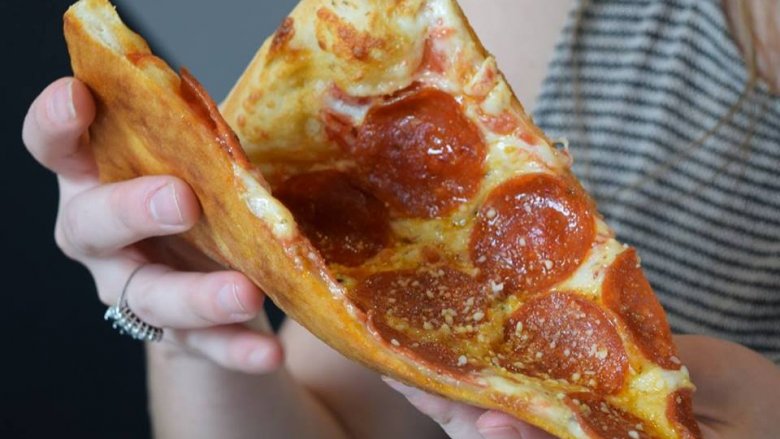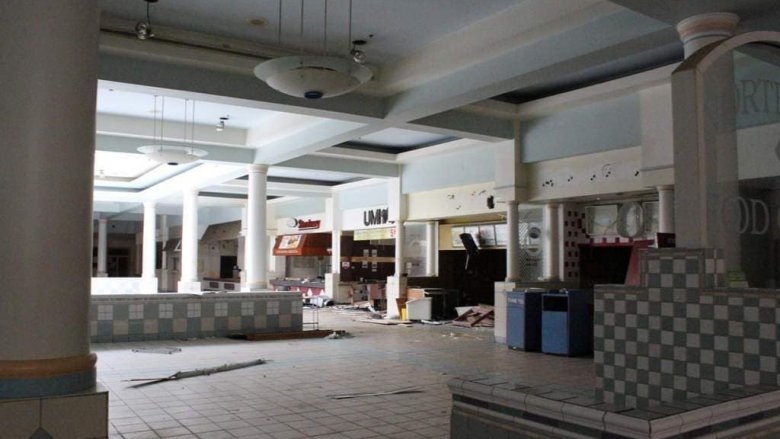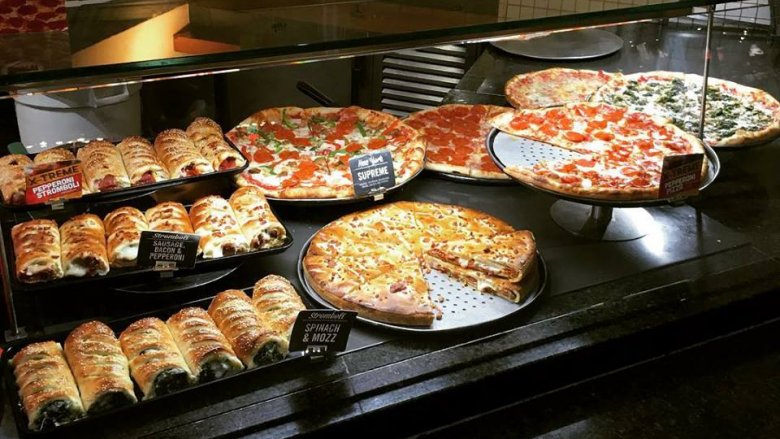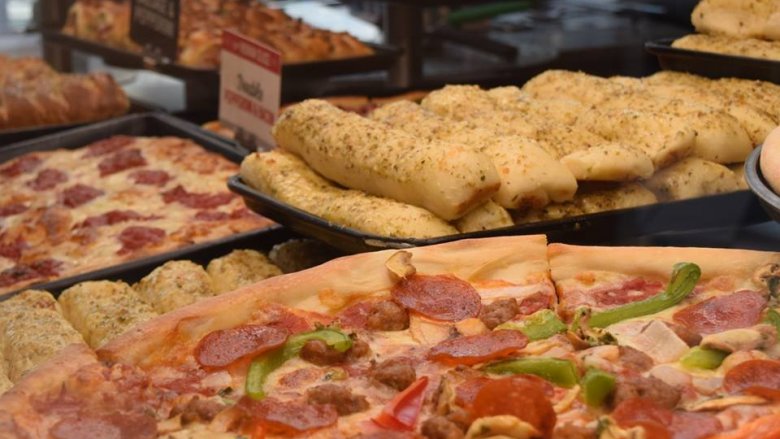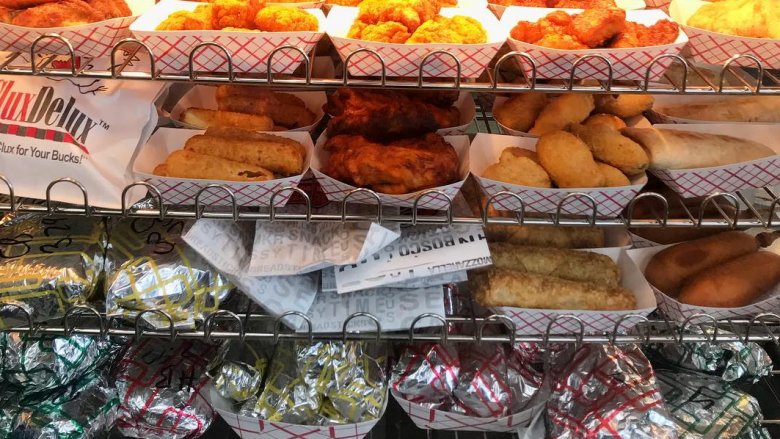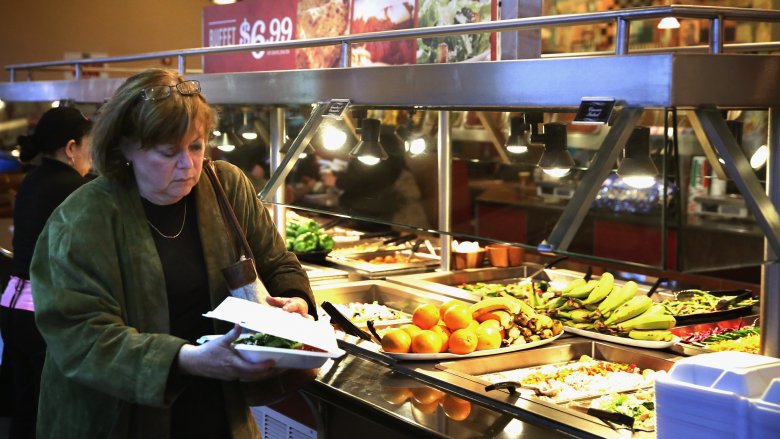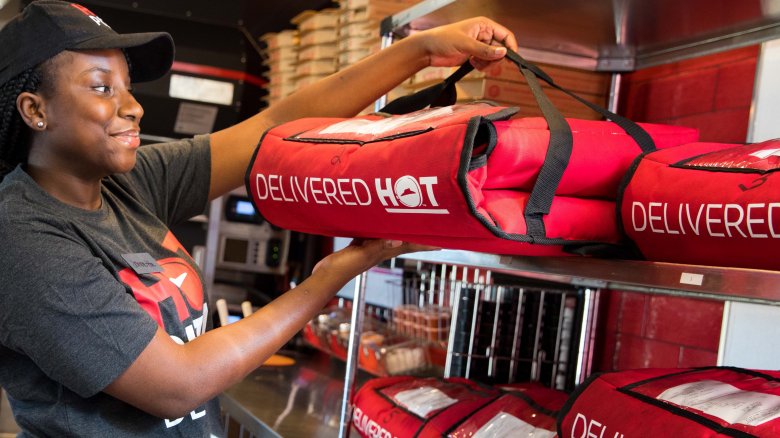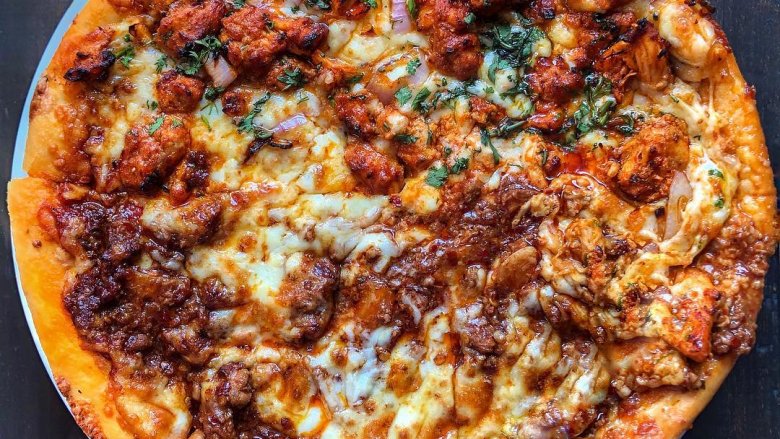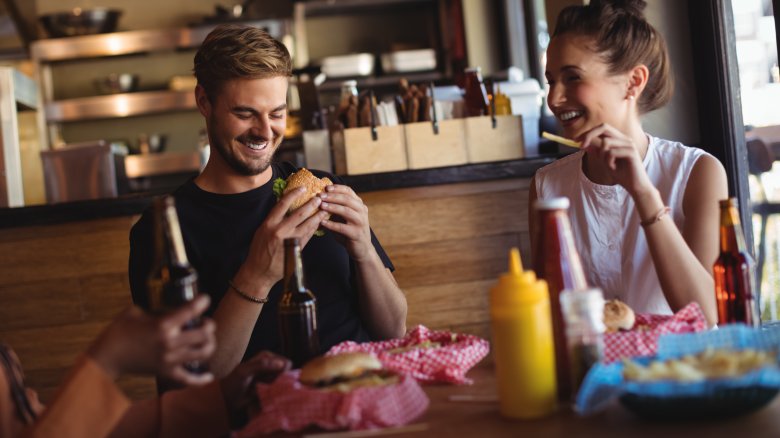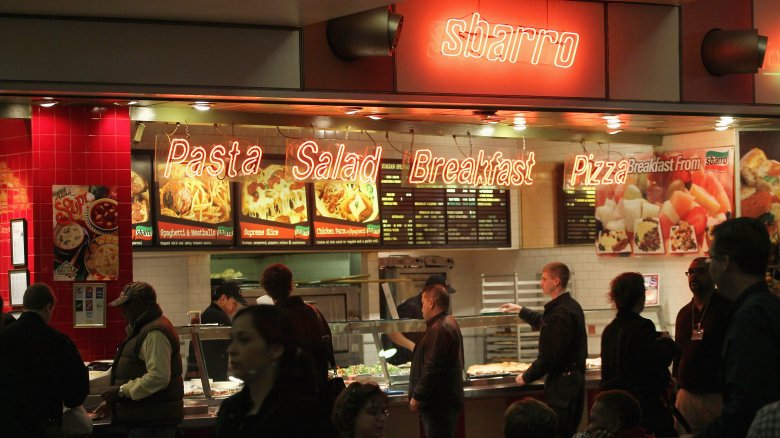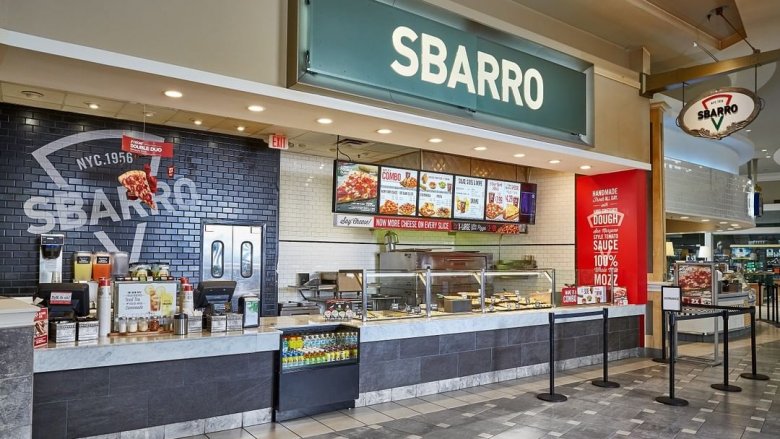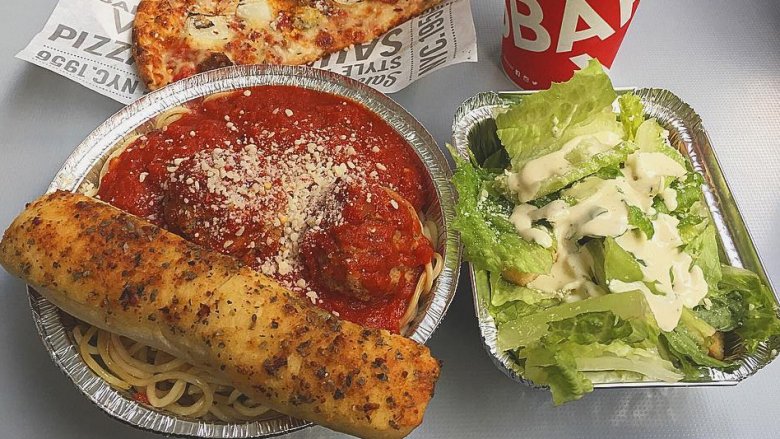Why Sbarros Are Disappearing Across The Country
If it's been a while since you've set foot in a shopping mall food court or been stranded at a regional airport in the middle of the afternoon, it's probably been a long time since you've eaten at a Sbarro, that middling staple of convenience food that features slices of too-sweet, too-doughy pizza served at room temperature. Turns out, you're not alone; in the last 15 years, the company has closed hundreds of stores, putting the total count at less than half of what it was in 2004. That year, the company was at its peak, generating $465 million dollars in sales spread across 762 locations.
What went wrong? What happened to this ubiquitous pizza chain, the former anchor of a Saturday afternoon shopping experience? How did it transform into just another victim of the suburban shopping mall decline, alongside KB Toys, Waldenbooks, Sam Goody, and Aeropostale? And is there anything the company can do to fight back, and reemerge a stronger, cheesier, saucier version of its former self? These are the reasons Sbarros are slowly vanishing nationwide.
Americans just aren't that into shopping malls anymore
The biggest problem Sbarro faces is the changing way in which Americans are doing their shopping. Sbarro's entire strategy was intrinsically tied to its shopping mall-only locations; while you could visit a Domino's Pizza or a Pizza Hut restaurant anytime you felt like, Sbarro locations tended to be located strictly in food courts.
The strategy worked fine, in the days when people would spend hours of their lives aimlessly wandering around gigantic, sprawling shopping malls, peeking in windows, throwing coins in the fountain, avoiding eye contact with pimply members of the opposite sex, and committing petty acts of vandalism. A stop at Sbarro fit into a day spent shopping quite naturally, since the mall was the only place to eat Sbarro's unique combination of slowly congealing cheese and oil-pooled pepperoni, and no trip to the mall would feel complete without a pit stop in the food court for a slice of pizza. However, with overall mall traffic on the decline, and Americans doing more and more of their shopping online, in big box stores, or in smaller specialty boutiques, Sbarro's sales are also faltering.
Sbarro carried too high a debt balance to survive the lean times
Most major corporations carry some amount of debt, as a means of managing their balance sheets and maximizing the potential return for investors. Under normal conditions and when applied carefully, a company carrying a debt balance isn't always, in itself, a bad thing. However, when that debt load gets too high, and when it coincides with several unlucky years of declining sales, a company can get in real trouble due to its decreased ability to move nimbly in response.
Sbarro's debt load was as unhealthy as much of its product. When business was booming, it wasn't an issue, but as sales started to slip, the company began a free-fall that ultimately landed it in bankruptcy court, twice. At its worst in 2011, Sbarro was $487 million dollars in debt, while holding just $471 million dollars in assets. Even after restructuring this debt through bankruptcy proceedings, the company still emerged with liabilities of $165 million; that's a lot to cover through the sales of slices of pizza sold almost exclusively in the abandoned, haunted halls of rapidly-declining shopping malls.
Pizza ingredient costs are on the rise
Your local pizza joint has some of the best profit margins in the restaurant business, which can reach as high as 20 percent. After all, the ingredients are cheap: A little flour, yeast, water, cheese, and toppings are all that you need to get started. By some estimates, a pepperoni and sausage pizza can cost as little as $1.90 to make. Sell that pizza for $14, and you're looking at a 636 percent markup. Even after the owner of a pizzeria pays for rent, heat, propane, insurance, and a few mildly interested staff members, those are still great numbers.
But what happens when the cost of these core ingredients starts to creep upward? Let's look at cheese, for example, since it can be one of the costliest ingredients for a pizza chain. In 2014, the cost of mozzarella cheese suddenly spiked by 16 percent, with cheddar cheese rising by about 25 percent overall. That may not seem like much, but for a massive chain like Sbarro or Papa John, for whom cheese cost represents 35-40 percent of their overall food cost, this can have a dramatic impact on profitability. In order to stay in the black, many pizza places have little choice but to raise prices, which can be tough for customers to swallow when sales are already in decline.
Pretty much every corner store now sells pizza
In the 1990s, one of the things that gave Sbarro cachet was the exclusivity of its product. If you wanted to get down on some greasy pizza, you had to find a pizza place — or, you know, your local food court.
Since then, however, pizza has become so ubiquitous that it's almost impossible to get away from. Pizza is EVERYWHERE, with some version of a slice being slung from the checkout stands at Target, to the mom-and-pop sandwich shop down the street. Grab a tank of gas at the local gas station, and you can probably add a slice of pizza to the experience for just a buck or two. The frozen food section of the supermarket is clogged with heat-and-serve pizzas, emblazoned with the faces of celebrities like Oprah Winfrey or Rachael Ray. And if all of that requires too much pre-planning or doesn't align with your growing disinterest in leaving the house, you can pick up the phone or fire up an app and have a pizza delivered right to your door within 20 minutes, at any time of the day or night. Pizza is literally everywhere, and Sbarro just doesn't feel as special as a result. If you want pizza, you aren't looking for Sbarro anymore.
Sbarro doesn't cook food fresh to order
You know how when you're trying to decide what to have for lunch, you always opt for the thing that's been sitting out for a while under fogged-up plexiglass, prepared minutes or even hours before you actually ordered it? Yeah, we don't either.
Because Sbarro's biggest asset is it's "always ready when you are" availability, most of the chain's food isn't cooked to order. And the tradeoff for that convenience is quality.
"Sbarro has been stuck with an outdated business model," says Michael Whiteman, a restaurant consultant and president of Baum & Whiteman LLC in Brooklyn, New York. "Its biggest shortcoming is that it sells food that has been sitting out for a while, and more people want food made to order."
Twenty years ago, we didn't think twice about ordering food that's been sitting under warmers, but these days, we know we don't have to go too far to get the fresh stuff.
Sbarro doesn't deliver, and that's a problem
Because Sbarro's most major foothold was in shopping malls and airport food courts, they missed out on a large slice of the pizza business: Delivery. Delivery accounts for about $70 billion dollars in pizza sales annually, with technologically advanced app-driven options from Domino's Pizza, Pizza Hut, and Papa John's leading the pack, generating about 45 percent of overall food delivery sales. Sbarro is now in the position of trying to play catch-up, as it finally realizes how important delivery is to the pizza business, but it's a rocky road.
"We're learning a lot," says chief marketing officer Anne Pritz. "It's a very challenging business. We had never done delivery or carryout before. And there's a lot of nuances. You have to master online ordering. You have to master customization. You have to master new products. And you have to make sure, ultimately, that you are not sacrificing the quality of your product when you're making those deliveries that are 20 miles or 20 minutes from your store."
Sbarro's social media game is weak
In spite of the best efforts of some poor young underpaid intern somewhere in a cubicle in Columbus, Ohio (where Sbarro is headquartered), Sbarro's social media presence just hasn't be able to capture the imaginations of customers the way their competitors have.
Sbarro's 300k Facebook followers may seem like plenty, until you punch up the pages of competing pizza chains. Pizza Hut's got 31 million followers. Domino's Pizza has 20 million. Even those sad sacks over at Papa John's are clocking 6 million fans.
So what's the deal with Sbarro's social media following, or lack thereof? The company posts the right mix of lifestyle photography, "edgy" memes that seem to be pleading for virality, contests, and all of the other junk straight out of the "social media marketing" playbook, which makes their relatively small following something of a puzzle. The answer may be very simple: Most of the people who unceremoniously cram a triangular box of pizza down their gullets aren't looking to memorialize the experience with a Facebook follow.
Fast food companies have some of the highest engagement rates on social media, so for Sbarro to not even have a seat at that table is a detriment, for sure.
Pizza trends are changing...and Sbarro isn't keeping up
For a food business based on such a simple combination of ingredients, the pizza industry continues to be an ever-evolving beast. It's up to restaurants like Sbarro to keep up with current shifts in consumer preference... and some restaurants do it better than others.
Pizzas with Buffalo wing sauce bases, Alfredo sauce, or barbecue sauce. Palate-confusing combinations like roasted pear and blue cheese. Inventive toppings, like tortellini, mac and cheese, or avocado. Exotic upgrades to standard-issue mozzarella, like Asiago or fresh buffalo mozzarella. Gluten-free or alternative-flour crusts. These are the options that more and more consumers are looking for, and other large pizza chains like Pizza Hut and Domino's Pizza are keeping up with expanded menus riddled with more choices, offering more options than ever for adventurous diners.
Not Sbarro. Sbarro is sticking with the tried-and-true formula of sweet red sauce, doughy crust, and as much cheap mozzarella heaped on each slice as humanly possible, even as consumers are moving on and ready to try new things.
The mall has much better options for food now
When shoppers DO still congregate at a shopping mall, they're still stopping for something to eat... they're just not stopping at Sbarro. When you look at Sbarro's numbers, it would seem that an overall downward trend in mall shoppers correlates with their declining business, right? Not so.
There are some malls that are still thriving today. And those malls still have food courts — some of them are even upgrading and expanding those food courts to meet customer demands. But the food courts you'll find at the mall today are nothing like food courts of the '90s. Today, hungry shoppers want local food, healthy eats, maybe even a side of locally-crafted beer. Sbarro might be there, somewhere between the Sweetgreen and the Bareburger, but we're willing to bet their line is a whole lot shorter than those other places.
There is nothing to distinguish Sbarro from any of its competitors
The fact that there are many fast food chains that are wildly successful at selling food that isn't very good is hardly news. Need evidence? Taco Bell, Arby's, and KFC all sell food that isn't objectively of particularly high quality. Instead, these companies employ other techniques to make their food and the experience of dining in their restaurants memorable.
Eat a Doritos Locos Taco Supreme from Taco Bell, and there's no confusion about where it came from, since no other company was struck with the divine inspiration to successfully wrap a taco in a giant nacho cheese tortilla chip. If you've eaten at an Arby's recently, it's probably got something to do with their creative and quirky television advertisements, narrated by H. Jon Benjamin, of "Bob's Burgers" and "Archer" fame.
In both examples, these companies employ techniques that exist outside of the realm of the actual quality of their food, in order to make them memorable and desirable. Who can ever remember any significant detail about eating at a Sbarro? That time there was maybe too many dried oregano sprinkles? The entire experience is bland, nondescript, and indistinguishable from its competitors.
Sbarro's attempts at rebranding got met with a big yawn
After emerging from bankruptcy protection in 2014, Sbarro was determined to address many of the problems we've outlined so far with a total branding overhaul. The dated font and Italian flags of the previous logo were gone, replaced by a clean, modern, sans-serif typeface tagged with the words "NYC.1956," in an effort to remind customers of the brand's Brooklyn roots.
The changes were more than merely cosmetic. In an effort to appeal more to customers' desire for fast casual-style eateries, Sbarro is also experimenting with freestanding restaurants, divorced from the declining foot traffic of the mall food court. "We've listened to our customers and are excited to take our concept out of the food court setting and into their neighborhoods," according to CEO J. David Karam, with the launch of both freestanding Sbarro restaurants and Pizza Cucinova, which features cooked-to-order pizzas made with artisanal ingredients including at least 100% more artichoke hearts, fired in wood-burning ovens in just three minutes.
These changes feel like steps in the right direction, but will they be enough to revamp Sbarro's sketchy image? Thus far, signs are pointing to no: In 2016, the chain still saw a 10.6 percent decline in sales over the previous year, and in 2017 it fell 5.5 percent.
The food isn't very good
After all of this talk, there's one final simple truth we kind of have to face, during any in-depth conversation about Sbarro: The food is, at best, just kind of eh, and people don't seem to like it very much.
Sure, we get it: Maybe if you've never seen or imagined pizza before, a trip to Sbarro can be exciting. But the best thing you can say about it is that it's serviceable; the kind of bland, unimaginative food that you might find in a middle school cafeteria, for example, or being slung at a fundraiser to buy new uniforms for the local basketball team. It's a cafeteria-style, assembly line, cartoonishly simplistic rendering of what a 7th grader thinks Italian food is supposed to be like, overflowing with bargain-basement mozzarella and slathered with painfully sweet tomato sauce.
This ode to mediocrity isn't a bargain, either. At around $3.50 a slice, anyone with even a casual interest in pizza can find a much better slice literally almost anywhere else. For a long time, Sbarro was able to build their brand based soley on the marketing concept that "eating pizza is better than not eating pizza, and here's pizza right now," but that doesn't seem to be enough to carry the company for much longer.
